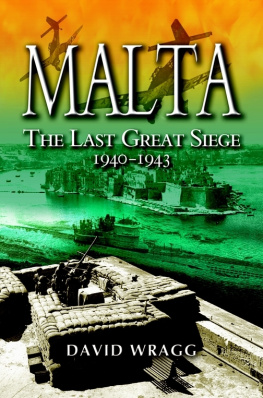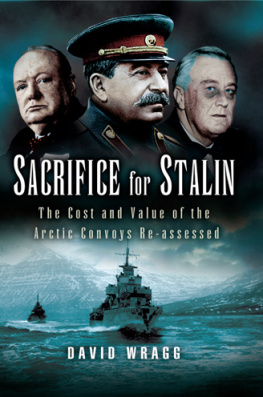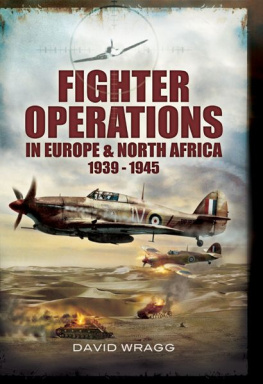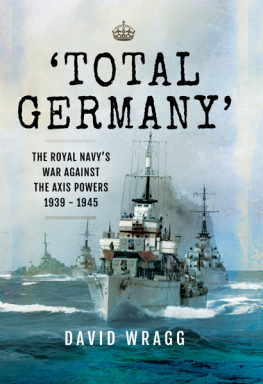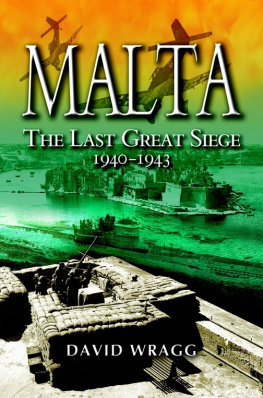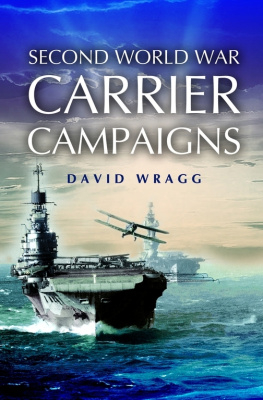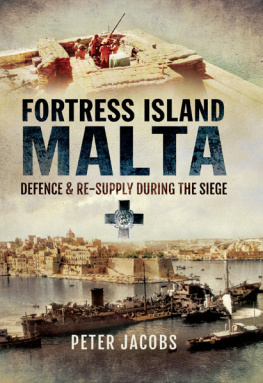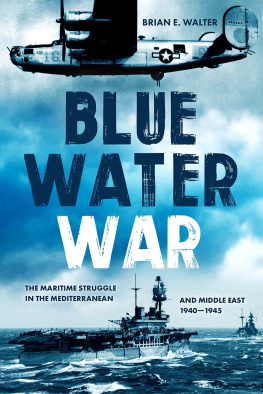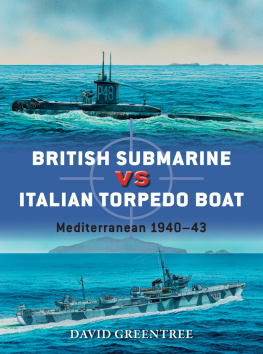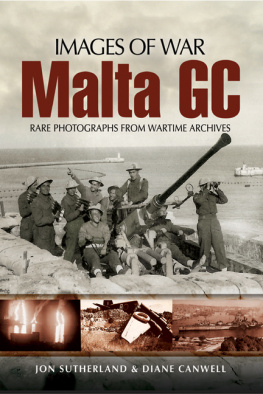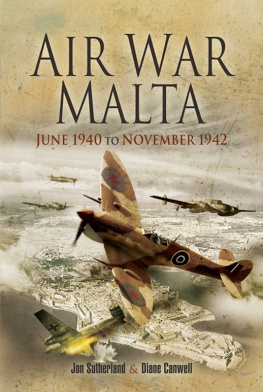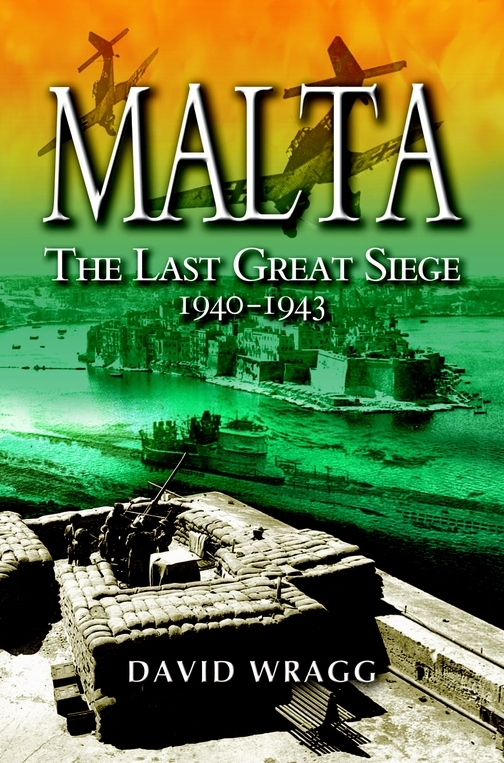Alanbrooke, Field Marshal Lord, War Diaries, 1939-1945 , Weidenfeld & Nicolson, London, 2001
Cunningham, Admiral of the Fleet Lord, A Sailors Odyssey , Hutchinson, London, 1951
Norman, Kathleen, For Gallantry: Maltas Story by a Navy Wife , Arthur Stockwell, Ilfracombe, 1956
Oliver, R. Leslie, Malta at Bay , Hutchinson, London, 1942 Malta Besieged , Hutchinson, London, 1943
Thomas, D. A., Malta Convoys 1940-1942: The Struggle at Sea , Pen & Sword, London, 1999
Night of Judgement, The Illustrious Attack on Taranto , Weidenfeld & Nicolson, London, 2003
CHRONOLOGY
1935
Italy invades Abyssinia, provoking crisis. AA defences of Grand Harbour strengthened, and plans laid for Fleet Air Arm attack on Italian fleet at Taranto.
1938
29 September, Munich Agreement allows German demands for Czechoslovak territory.
1939
16 March, German troops enter Prague completing annexation of Czechoslovakia.
7 April, Italian troops enter Albania.
20 April, British merchant shipping banned from Mediterranean.
July, Governor of Maltas Advisory Council creates Central Committee.
September, District Committees start to be formed on a parish basis throughout Malta. First two battalions of Territorial Kings Own Malta Regiment ready by end of month.
3 September, United Kingdom and France declare war on Germany following invasion of Poland.
1940
2 3 May, Blackout practice between 22.00 and dawn.
11 May, Air raid warning practice.
20 May, Newspapers carry appeal for volunteers for what was to become the Malta Volunteer Defence Force.
27 May, Curfew introduced between 23.00 and 05.00. Emergency hospitals established.
10 June, Italy declares war at midnight if Malta is not surrendered.
11 June, First Italian air raid at 07.00.
15 June, Governor announces protection officers to work with district committees.
17 June, French seek armistice. In Malta, seven Economical Kitchens are already operating to help feed refugees from the towns.
22 June, Armistice signed by France and Germany.
25 June, Italy signs armistice, which now takes effect, leaving Britain standing alone. French troops in Egypt outnumber those of Britain.
26 June, Bomb hits a bus crowded with passengers at Marsa, killing twenty-eight people.
30 June, First offensive operation from Malta: 830 Naval Air Squadrons Fairey Swordfish attacking the port of Augusta.
10 July, Convoy MA-5 evacuates British civilians and dependents to Alexandria. All eight ships arrive safely.
13 July, From midnight, private cars and hire cars other than taxis banned.
19 July, 830 Squadron sinks a U-boat.
12 August, Twelve Hawker Hurricane fighters flown to Malta from HMS Argus .
15 August, Last day on which sales of ice cream permitted.
1 September, First convoy arrives. All three ships in MF-2 reach Malta safely from Alexandria.
5 September, First appearance of Junkers Ju87 Stuka dive-bombers in Italian markings.
13 September, Italian forces invade Egypt.
21 September 21 October, Police crackdown on overcharging in food shops.
11 October, Convoy MF-3 arrives from Alexandria with all four ships.
13 October, Taxis banned and hours of bus operation curtailed. 9 November, Convoy MW-3 arrives safely from Alexandria with all five ships.
11 12 November, Successful Fleet Air Arm attack on Taranto using aircraft from HMS Illustrious and Eagle flown off the former ship, crippling half of Italys battleships.
17 November, Fourteen Hurricanes flown off Argus , but only four manage to reach Hal Far as the others run out of fuel.
26 November, Convoy MW-4 arrives safely with all four ships from Alexandria.
29 November, Convoy code-named Operation Collar from Gibraltar arrives safely with two ships.
20 December, Convoy MW-5 arrives safely from Alexandria with eight ships. Cunningham aboard HMS Warspite enters Grand Harbour on first visit since May, to a warm welcome.
December, Government ensures abundant supplies of kerosene to allow householders to lay down reserves.
December January, Luftwaffe moves Fliegerkorps X from Poland to Sicily.
1941
10 January, Convoy operation Excess nears Malta from Gibraltar with one ship for Malta and several for Alexandria, with another two ships in MW-5 from Alexandria. In heavy aerial attacks by the Luftwaffe and Regia Aeronautica , HMS Illustrious is crippled and limps into Grand Harbour.
13 January, Start of the Illustrious blitz.
16 January, Heaviest air raid to-date, fifty-three Maltese civilians killed, 300 houses destroyed in Senglea.
23 January, Illustrious leaves Grand Harbour after nightfall.
February, Rationing announced. Conscription introduced. U-class submarines deployed to Malta for the first time, as well as four J-class destroyers.
6 February, Rommel ordered to take command in North Africa with two crack German divisions; he urges that Malta be invaded.
March, Air raid precautions eased to allow work to continue away from target area, while during previous four months, Axis shipping losses exceeded 100,000 tons.
28 March, Mediterranean Fleet sinks three Italian cruisers and two destroyers in the Battle of Cape Matapan.
April, Lieutenant Commander Wanklyn in Upholder starts a year of successful attacks against Axis convoys.
3 April, Axis forces in North Africa take Benghazi.
7 April, Rationing introduced.
11 April, Good Friday, but church bells are rung for the first time ever in Malta on this day to sound the all clear after Luftwaffe air raids.
12 April, Twenty Hurricanes flown off Ark Royal , boosting strength of 261 Squadron.
15 16 April, In a successful night action, Malta-based destroyers wipe out Italian convoy of five ships and sink one of the three escorts, but HMS Mohawk is sunk.
20 21 April, A single ship, the armed-tanker Breconshire , arrives from Alexandria protected by naval forces.
21 April, Mediterranean Fleet bombards Tripoli just before daybreak following air raids by Malta-based RAF and Fleet Air Arm aircraft.
27 April, Germans enter Athens.
28 April, Dockyard Defence Battery disbanded, and its role taken over by the Royal Malta Artillery.
May, Rationing extended to kerosene. Coffee, tea, sugar, lard, margarine, rice and matches all rationed by this time.
9 May, Convoy MW-7 arrives from Alexandria with seven ships, although two badly damaged, one by a torpedo and the other by a mine.

